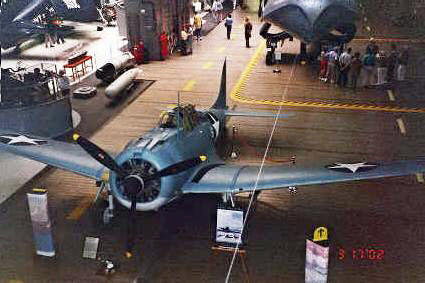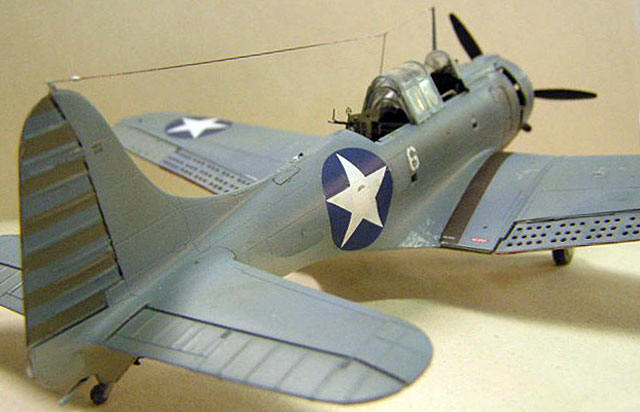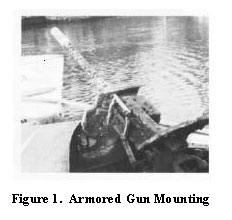Few battles on land, sea or air have been so exhaustively
studied and analyzed than the great naval battle near the island of Midway on
June 4, 1942. This article is the first of three that looks at the participation
of USMC aviation units based on the island.
The Squadron
VMSB-241 was created as a “paper” squadron in Marine Air
Group 22 on 1 March 1942, along with (ultimately) VMF-221. The rapid expansion
of Marine air in the years and months leading to war saw much swapping of
squadron numbers, airplanes and personnel. On Midway, at least two VMSB
squadrons morphed into VMSB-241 by the time of the battle. This squadron would
operate two airplanes, the SBD and the SB2U; operationally the two types would
act in effect as separate squadrons.
Most of the pilots and gunners had adequate to good
training; none had any combat experience. Fuel shortages on the island reduced
training opportunities in the days leading up to June 4. Ponder if you will,
that 241 got it hands on the SBDs on May 26, leaving about nine days for
training in type before heading out to take on the Kido Butai on June 4.
The Airplane

Figure SEQ Figure \* ARABIC 3. BuNo 2106 at the National Naval Aviation
Museum.
Courtesy LCDR Jennifer Lyons USN
I first read about the recovery of this airplane from Lake
Michigan several years ago, and have had the opportunity to see it in the
Pensacola Museum. Surely it is the only surviving Golden Wings airplane with the
original orange-yellow paint sprayed on 65 years ago. Delivered on December 28,
1940 at the Douglas El Segundo plant, 2106 was accepted by the navy the same day
and ferried to NAS North Island. There it was assigned to VB-2 in whose colors
it had been painted during construction. 2106 would remain with VB-2 and
Lexington for over a year. VMSB-241’s SBD-2s were ex-VB-2 aircraft turned
over to the Marines starting in mid- 1941 as the SBD-3 became available to stock
navy VB/VS squadrons. BuNo 2106 did not participate in the Battle of the Coral
Sea:
When Lexington and her embarked air group had
sailed for the South Pacific in late April, BuNo 2106 had remained behind-to
be shuffled over the next month from the Battle Force pool to Carrier
Aircraft Service Unit (CASU) 1, to VB-3, to another pool, and ultimately,
late in May 1942, to the Second Marine Aircraft Wing. Subsequently, BuNo
2106 became 1 of 19 SBD-2s shipped to Midway in the aircraft transport Kitty
Hawk (AVP-1) that arrived there on 26 May 1942.
Events of June 4
(from the After-Action Report of 1st Lt Iverson, 2106’s pilot)
I took off with SBD-2 unit, Major Henderson leading at 0555. We
rendezvoused at Point Affirm, altitude 3,500 feet. I was in box behind Major
Henderson. Captain Glidden was leading the box. The squadron climbed to 9,500
feet on course of 330 magnetic. We sighted the enemy fleet at 0755 just to port
of our course, distance twelve (12) to fifteen (15) miles. I left Captain
Glidden's box and joined up on Major Henderson's box where I remained until
attack. My radio was out of commission; I had no intercockpit communication…No
attack signal was given. At 1,500 feet I selected a carrier target and pealed
off through a thin cloud. Two enemy fighters followed me in the dive. The
carrier I hit was one of three (3) that I saw…After observing my bomb explosion
and a smoking carrier, I threaded away from the fleet on a course of 240
degrees. Two other fighters joined the fighters already attacking me, one or two
of these fighters had fixed landing gear and an estimated speed of 300 knots.
The fighters pursued us making overhead
runs for twenty or thirty miles, when I was able to gain altitude and get into
the clouds. Evasive action over water was not effective. I had release[d] my
bomb at 300 feet and pulled out into level flight over water. I used full
throttle and 2300 rpm. with cowl flaps open. Engine functioned perfectly. I
could not estimate my speed as my airspeed indicator was shot out of commission.
My plane was hit several times, by what I believe to be both fighters and
anti-aircraft. My throat mike cord was severed by a bullet and my hydraulic
system was shot away…
Reference
(Willis) provides a marvelous assessment of this airplane; it is available on
line and I will not quote further from it except to note that 2106’s exposure to
Zero 7.7mm fire resulted 210 to 259 bullet holes, depending on which source is
quoted.
With this kit I have now done BuNo 2106 in four
of its five incarnations. The kit is of course the Accurate Miniatures Dauntless
marketed as a VMSB-241 SBD-2. This kit is identical to AM’s SBD-3 release with
the exception of the decals and some of the historical text in the instruction
sheet.

The kit as molded was built OOB with the
following exceptions:
1.
A 500 lb bomb (looks like SAP to me) surplused from an AM Avenger in lieu
of the kit 1000 lb GP bomb. The lighter weapon is what VMSB-241 took to war on
June 4, 1942.
2.
The cowl flaps were removed in preparation for using Eduard P/E
replacements. Regrettably, the latter turned out to be incorrect, so the kit
flaps got reinstalled in the open position.
 The
kit was enhanced with pieces from Eduard P/E set 48-225:
The
kit was enhanced with pieces from Eduard P/E set 48-225:
1.
Various sections of the instrument panel
2.
Gear up/down indicator by track way for left rudder pedal
3.
Gunner’s Seat belt.
4.
Ring and Bear gun sight for the .30 flex gun.
5.
Face armor with vision slit for
the .30 flex gun
6.
Catapult hooks
Other Enhancements:
-
2106 came out of Lake Michigan with an
armored gun mount. Plastic card was used to represent that armor at the
forward end of the gun receiver, supplementing the face armor just forward
of the spade grips.
-
Nine thou steel
wire was used for the radio antenna and its lead-in.
All USN/USMC aircraft involved in the Midway
battle had by June 4 assumed the painting and marking scheme that would remain
in use into 1943. In the month preceding the battle all vestiges of the color
red were removed – the red circle in the center of the national insignia
roundel, and the red (and white) rudder stripes. By this time 2106 has had its
Blue-Gray coloration for about six months, and fading is in evidence. The model
got a topcoat of Polly Scale Blue-Gray lighted with some Polly Scale white. This
was over sprayed with straight Blue-Gray to give a fading effect. The under
surfaces were done in Polly Scale USN Light Gray.
Kit decals were used throughout over an
airbrushed coat of Future, the nifty rudder decal duplicating the hurried
repainting of the rudder stripes. Model Master Clear Acryl Flat then toned down
the gloss future. Finally a pastel chalk close to Blue-Gray was selectively
applied to further show fading. Other chalks indicate oil seepage and the like.
Close-ups of 2106 on Midway after the battle
show the tiny type, service and BuNo painted on the fin and rudder, Of
particular note, the BuNo was repainted over the blue-gray sprayed over the
rudder stripes and that “NAVY” was not replace by “Marines” on the fin.
During its time with VB-2, BuNo 2106 and other
VB-2 SBD-2s would participate in the 1941 “Louisiana Maneuvers” along with other
army, navy and marine aircraft. While so employed, the SBD-2s experienced
substantial engine wear when exposed to dust conditions not normally found in
shipboard operations. BuNo 2106’s engine required replacement after this
experience, which is why this aircraft was at NAS Ford Island on December 7,
1941.

Perhaps while engaged in the Louisiana
Maneuvers, it may have over- flown another maneuvers participant, the 108th
Cavalry Regiment of the Georgia National Guard, which included in its ranks PFC
Joseph E Lyons, my father. Dad really liked horses.
All photos are mine, in the public domain, or
where separately credited.
a.
Cressman, R. (1994). Dauntless in War: Douglas SBD-2 BuNo 2106. Naval
Aviation News, July-August 1994, 24-26.
b.
Ewing, S., Cohen, S., Cressman, R., Horan, M., Reynolds, C., & Reynolds,
C. (1990). A Glorious Page in Our History the Batlle of Midway 4-6 June 1942.
Missoula MN: Pictorial Histories Publishing.
c.
Karppi, W. (1995). The Ghost of Midway. Naval Aviation News,
November-December 1995, 22-23.
d.
Kinzey, B (1995). SBD Dauntless in detail & scale. Waukesha, WI:
Kalmbach Publishing.
e.
Stern, R. (1984). SBD Dauntless in Action. Carrollton, TX:
Squadron/Signal Publications.
f.
Willis, R (1997). Dauntless in Peace and War. A Preliminary
Archaeological and Historical Documentation of Douglas SBD-2 Dauntless BuNo
2106, Midway Madness. Washington: Naval Historical Center.
Modelling the P-47
Thunderbolt
Osprey Modelling 11 |
|
|
|
|
Author: Brett Green
US Price: $17.95
UK Price: £12.99
Publisher:
Osprey Publishing
Publish Date:
July 25, 2004
Details: 80 pages; ISBN: 1841767956 |
|
|
Home
| What's New |
Features |
Gallery |
Reviews |
Reference |
Forum |
Search